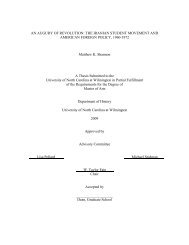HIERARCHAL INDUCTIVE PROCESS MODELING AND ANALYSIS ...
HIERARCHAL INDUCTIVE PROCESS MODELING AND ANALYSIS ...
HIERARCHAL INDUCTIVE PROCESS MODELING AND ANALYSIS ...
You also want an ePaper? Increase the reach of your titles
YUMPU automatically turns print PDFs into web optimized ePapers that Google loves.
models of natural systems are non-unique, there is multiple ways to represent the<br />
same dynamic. Creating computational tools that would quickly and automatically<br />
evaluate multiple models seemed to be a promising idea to search through the extensive<br />
model space. The success of machine learning and data mining in commercial<br />
domains led scientists to investigate the field of automated modeling to serve that<br />
particular purpose (Fayyad et al., 1996).<br />
The act of gathering small pieces of information and combining it to prior knowledge<br />
to formulate a complex overview of an object or process studied is called induction.<br />
Induction prevents from searching the entire space of possible equations<br />
by only piecing together the meaningful terms, for instance a predator-prey model<br />
will need terms specifying growth and death (Todorovski et al. 2005). Inductive<br />
modeling methods (i.e. LAGRAMGE, HIPM, ARIMA, FUSE) use the principles of<br />
induction to construct models of the studied system. Methods used for commercial<br />
application, such as Knowledge Discovery in Database (KDD) process, were insufficient<br />
for scientific purposes as they only described and did not explain the observed<br />
system behavior (Langley et al. 2006). A simple example would be the modeling of<br />
water consumption in a city, a water company could easily create a numerical model<br />
based on previous years that would give a good estimate of the projected water<br />
consumption over time but it may not explain why the consumption fluctuates the<br />
way it does. In other words the commercial methods were able to produce models<br />
that are useful when trying to make accurate predictions for a system but become<br />
very limited when trying to explain which processes drive systems behaviors; these<br />
methods did not explore the realm of all possible models. Thus, induction methods<br />
had to be enhanced to automate the task of building and evaluating multiple models<br />
(Dzeroski et al. 1995).<br />
In this thesis, I used the hierarchal inductive process modeling technique, which<br />
is encoded as computer algorithm called HIPM (Langley et al. 2006; Bridewell et<br />
2
















